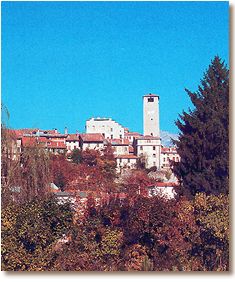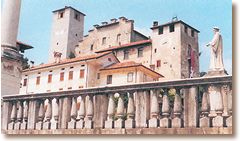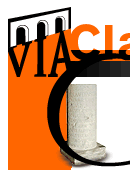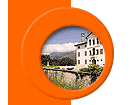|
 eltre
is a noble town lying on a strategic and favourable position for
the direct connections towards the Po plains. It boasts mythological
origins (from the Asiatic prince Ferrato, presumably from Eligio,
leader from the Euganean area arrived in Feltre once his people
had been expelled by Antenore, founder of Padua or presumably from
the same Lybian Ercole) Remarkable remains proving its strategic
position date back from the middle and late Bronze Ages. Earlier
remains refer to steady settlements dating back to the second Iron
Age (5th, 6th century B.C.). Plinio il Vecchio refers to Feltre
as a Raetic town which, like several other town belonging to the
Gallia Cisalpina, was included in the Roman Empire in the 2nd century
B.C. It reached its administrative independence between 49 and 42
B.C. It was included in the tribe Menenia, one of the 35 Roman tribes.
The presence of high magistrates was proved by remains such as IVVIRI
IURE DICUNDO (Quattuorviri giusdicenti i.e. Lord Mayors), DECURIONES
(members of the town hall, so called ORDO DECURIONUM) and PRAEFECTI
IURE DICUNDO. eltre
is a noble town lying on a strategic and favourable position for
the direct connections towards the Po plains. It boasts mythological
origins (from the Asiatic prince Ferrato, presumably from Eligio,
leader from the Euganean area arrived in Feltre once his people
had been expelled by Antenore, founder of Padua or presumably from
the same Lybian Ercole) Remarkable remains proving its strategic
position date back from the middle and late Bronze Ages. Earlier
remains refer to steady settlements dating back to the second Iron
Age (5th, 6th century B.C.). Plinio il Vecchio refers to Feltre
as a Raetic town which, like several other town belonging to the
Gallia Cisalpina, was included in the Roman Empire in the 2nd century
B.C. It reached its administrative independence between 49 and 42
B.C. It was included in the tribe Menenia, one of the 35 Roman tribes.
The presence of high magistrates was proved by remains such as IVVIRI
IURE DICUNDO (Quattuorviri giusdicenti i.e. Lord Mayors), DECURIONES
(members of the town hall, so called ORDO DECURIONUM) and PRAEFECTI
IURE DICUNDO. 
|
 |

 nscriptions
in the feltrino area prove the presence of some Collegia (associations)
such as Fabri (blacksmiths), Centonari (rag dealers who re-used
old fabrics and manufactured blankets for fire extinguishing by
using pieces of old clothes (centones) ), Dendrophori (woodsmen,
craftsmen, merchants, and dealers in the processing, sale and transportation
of wood) Some excavations underneath Piazza Duomo brought to light
a remarkable historical borough belonging to the ancient Feltria
which dates back to the II and IV century A.D.. Some other findings
on the Colle delle Capre (location of the castle and presumably
seat of the Roman forum) and along the slopes of the Colle help
us recognize the difficult town plan. The remains of a road consisting
of basoli (lava stones) refer to the excavation works underneath
Feltre's cathedral. The road stretched from east to west, was connected
to a paved path presumably leading to the Colle. Another road on
the opposite direction adjacent to a building, presumably a house.
Among the other structures brought to light there were shops, one
of which connected to the house, as customary in the Roman age,
maybe a schola, i.e. seat of some professional associations (see
above Fabri, centonarii and dendrophori). A structure whose use
is still unknown, a building connected to a 11th 13th-century-baptistery
featuring a circular plan and a second floor with balcony. nscriptions
in the feltrino area prove the presence of some Collegia (associations)
such as Fabri (blacksmiths), Centonari (rag dealers who re-used
old fabrics and manufactured blankets for fire extinguishing by
using pieces of old clothes (centones) ), Dendrophori (woodsmen,
craftsmen, merchants, and dealers in the processing, sale and transportation
of wood) Some excavations underneath Piazza Duomo brought to light
a remarkable historical borough belonging to the ancient Feltria
which dates back to the II and IV century A.D.. Some other findings
on the Colle delle Capre (location of the castle and presumably
seat of the Roman forum) and along the slopes of the Colle help
us recognize the difficult town plan. The remains of a road consisting
of basoli (lava stones) refer to the excavation works underneath
Feltre's cathedral. The road stretched from east to west, was connected
to a paved path presumably leading to the Colle. Another road on
the opposite direction adjacent to a building, presumably a house.
Among the other structures brought to light there were shops, one
of which connected to the house, as customary in the Roman age,
maybe a schola, i.e. seat of some professional associations (see
above Fabri, centonarii and dendrophori). A structure whose use
is still unknown, a building connected to a 11th 13th-century-baptistery
featuring a circular plan and a second floor with balcony.
|






![]() Local
Traditions
Local
Traditions ![]() Local
Traditions
Local
Traditions 


